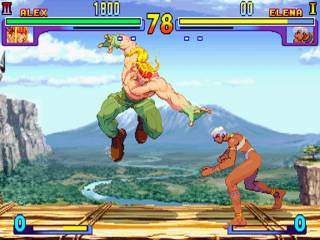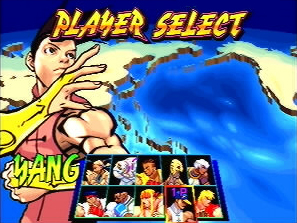Overview

Street Fighter III: New Generation, sometimes known in North America simply as Three: A New Generation of Street Fighters, is a 2D fighting game developed and released by Capcom for arcades (using their CP System III hardware) on February 4, 1997.
The direct successor to the Street Fighter II series of games, Street Fighter III features a new graphical style (with more elaborate sprites and animations), a new playable character roster (most of whom are original fighters), and a revamped gameplay system. Along with using gameplay mechanics from other Capcom games, it introduces three key features: parrying, universal overhead attacks ("leap attacks"), and the "Super Art" system (super combos that must be selected when choosing a fighter).
Similar to Street Fighter and the Street Fighter II series, the game's story focuses on a single tournament: the World Warrior Tournament. A new band of fighters enter for different reasons, some of which involve the tournament's sponsor (Gill, the leader of a mysterious organization). The only characters to make their return from previous Street Fighter games are the two series protagonists, Ryu and Ken.
The game later received two direct sequels: Street Fighter III: 2nd Impact - Giant Attack and Street Fighter III: 3rd Strike - Fight for the Future. It was later ported to the Dreamcast alongside 2nd Impact as Street Fighter III: Double Impact (Street Fighter III: W Impact in the Japanese version) in Japan on December 16, 1999, in North America on June 19, 2000, and in Europe on September 15, 2000. It was later included in the Street Fighter 30th Anniversary Collection compilation on May 29, 2018.
Gameplay
Although much of the gameplay from the Street Fighter II series is the same, including the traditional six-button (two punch, two kick) control scheme, the game includes a variety of new gameplay mechanics:
- Parries, known in Japan as "Blocking", is as riskier alternative to guarding that allows players to deflect non-throwing attacks, completely negating chip damage and reducing the animation stun enough to allow a punishing counter-attack. As guarding requires the player to move the joystick backwards, parrying requires the player to move the joystick forwards (for high attacks) or downwards (for low attacks), leaving them vulnerable if mistimed. It can also be performed while in mid-air.
- Super Arts, which build on the Super Combo system from Street Fighter II by allowing players to choose which of three powerful super moves (known as "Super Arts") they can perform in the match. Each Super Art affects the length of the Super Art Gauge and how many "stocks" of the gauge can be kept, which can allow players to perform certain Super Arts multiple times in quick succession.
- Dashing, which allows the fighter to quickly advance or retreat on the ground by having the player tap either direction twice on the joystick in quick succession.
- High Jump, which allows the fighter to make a higher jump by tapping downwards on the joystick before tapping upwards. Forward and backward jumps can also be made higher and longer by tapping the opposite direction before jumping (such as down-back before jumping forward).
- Quick Standing, which allows the player to have their fighter recover from a non-thrown knockdown faster by tapping down on the joystick as they land.
- Leap Attacks, which are universal overhead attacks in which the fighter does a short jumping strike that cannot be blocked while crouching. This is performed by pressing tapping down twice on the joystick and then pressing any attack button.
Characters
 The character select screen.
The character select screen.- Yun / Yang - Twin brothers and kung fu experts from Hong Kong, entering the tournament to show off their skills. Yang can only be accessed with a special command and has the same movelist as Yun (being a "palette swap" similar to Ryu and Ken).
- Oro - An ancient, mysterious hermit who mastered the secrets to immortality. He enters the tournament to seek potential candidates to teach his unique fighting style.
- Ibuki - An aspiring ninja from Japan who is sent by her clan to retrieve a mysterious file from Gill's organization.
- Elena - A tribal princess from Kenya who seeks to travel the world, using her elaborate capoeira in battle.
- Ryu - Returns from previous Street Fighter games. A wandering martial artist from Japan who seeks worthy opponents to improve his skills.
- Ken - Returns from previous Street Fighter games. An experienced martial artist from the U.S.A. who seeks to test his strength against his friend and rival Ryu.
- Gill - Final boss and only playable in the Dreamcast version. Leader of a secret organization that seeks to turn the world into his own utopia. Has the power to manipulate both fire and ice.
Soundtrack
 The soundtrack CD.
The soundtrack CD.- "Jazzy NYC (Underground Edit)"--New York stage 1
- "Leave Alone"--London stage
- "Crowded Street"--Hong Kong stage
- "Sharp Eyes"--Japan stage 1
- "Good Fighter"--Japan stage 2
- "Tomboy"--Africa stage
- "Get on a Train"--Siberian Railway stage
- "Cave Man"--Brazil stage
- "The Judgement Day"--Greece stage
- "Jazzy NYC (Street Edit)"--New York stage 2
Log in to comment